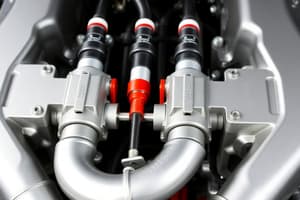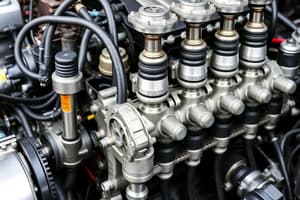Podcast
Questions and Answers
What is the primary factor that determines fuel supply in a carburetor system?
What is the primary factor that determines fuel supply in a carburetor system?
- Pump pressure
- Fuel speed at the point of injection
- Air velocity passing through the throat (correct)
- Engine temperature
Which of the following is NOT a listed advantage of fuel injectors?
Which of the following is NOT a listed advantage of fuel injectors?
- Better acceleration and starting
- Correct and uniform mixture distribution
- Higher initial cost (correct)
- Improved volumetric efficiency
In fuel injection systems, what is a critical requirement concerning the timing of fuel injection?
In fuel injection systems, what is a critical requirement concerning the timing of fuel injection?
- It should always be the same regardless of conditions
- It can be easily changed without affecting performance
- It should be uniform across all cylinders
- It must vary according to engine load and speed (correct)
Which problem is commonly associated with carburetor systems in multi-cylinder engines?
Which problem is commonly associated with carburetor systems in multi-cylinder engines?
What is the main function of the pumping element in a fuel injection system?
What is the main function of the pumping element in a fuel injection system?
What is the primary function of the metering control in fuel injection systems?
What is the primary function of the metering control in fuel injection systems?
Which of the following describes an advantage of using an air injection system?
Which of the following describes an advantage of using an air injection system?
What type of injection system is characterized as 'Air-Less Mechanical Injection'?
What type of injection system is characterized as 'Air-Less Mechanical Injection'?
What role does the governor play in a fuel injection system?
What role does the governor play in a fuel injection system?
What is the consequence of not adjusting the fuel supply at higher engine speeds?
What is the consequence of not adjusting the fuel supply at higher engine speeds?
Why is proper atomization of fuel crucial in injection systems?
Why is proper atomization of fuel crucial in injection systems?
What may occur at idling speeds if the fuel supply is not properly controlled?
What may occur at idling speeds if the fuel supply is not properly controlled?
What effect does the design of a fuel injector have on combustion?
What effect does the design of a fuel injector have on combustion?
How does an increase in engine load affect fuel supply from the pump?
How does an increase in engine load affect fuel supply from the pump?
What is a common feature of fuel injection systems that manage the pressure for fuel preparation?
What is a common feature of fuel injection systems that manage the pressure for fuel preparation?
Flashcards
Fuel Atomization
Fuel Atomization
The process of breaking down fuel into fine droplets, creating a larger surface area for better mixing and ignition with air.
Carburetor fuel delivery
Carburetor fuel delivery
This system delivers fuel to the engine based on the air velocity passing through the engine's intake. The faster the air, the more fuel is delivered.
Fuel injector delivery
Fuel injector delivery
This system uses a pump to control fuel delivery, delivering a set amount of fuel regardless of air flow.
Volumetric Efficiency
Volumetric Efficiency
Signup and view all the flashcards
Injection timing and rate
Injection timing and rate
Signup and view all the flashcards
Metering Element
Metering Element
Signup and view all the flashcards
Metering Control
Metering Control
Signup and view all the flashcards
Timing Control
Timing Control
Signup and view all the flashcards
Mixing Element
Mixing Element
Signup and view all the flashcards
Fuel Injection System Classifications
Fuel Injection System Classifications
Signup and view all the flashcards
Air Injection System
Air Injection System
Signup and view all the flashcards
Solid Injection (or Air-Less Mechanical) System
Solid Injection (or Air-Less Mechanical) System
Signup and view all the flashcards
Injection Pump Governor
Injection Pump Governor
Signup and view all the flashcards
Fuel Injector Design
Fuel Injector Design
Signup and view all the flashcards
Injection Pressure Impact
Injection Pressure Impact
Signup and view all the flashcards
Study Notes
Fuel Injection System
- Fuel injection is a crucial component affecting the performance and operation of internal combustion engines (specifically, CI engines).
- Both fuel injection and carburetors aim to prepare and deliver a combustible mixture to the engine, per its needs.
- However, their methods differ.
Fuel Atomization
- Both systems require fuel atomization before ignition for proper mixing with air.
- For carburetors, incoming air velocity needs to be higher than fuel velocity.
- Injectors require the fuel velocity to be greater at the injection point.
Fuel Supply
- In carburetors, fuel supply depends on the amount and velocity of air passing through the throat.
- Injectors rely on pump pressure for fuel supply.
Carburetor Problems
- Maldistribution of fuel in multi-cylinder engines.
- Loss of volumetric efficiency due to passage restrictions.
- Freezing at low temperatures.
- Surging in the secondary tank due to tilting.
- Risk of fire from backfires.
- Vapor leakage in extreme heat.
- Excessive fuel supply.
Injector Advantages
- Correct and uniform mixture distribution.
- Improved volumetric efficiency.
- Freedom from icing issues.
- Better starting and acceleration.
- Absence of tilting problems.
- Better fuel control.
Injector Disadvantages
- Higher initial cost and complex design.
- High maintenance costs.
- Bulkier and heavier.
- More noisy.
- Requires a specific fuel type.
Fuel Injection System Objectives
- Meet engine demand for fuel volume.
- Distribute fuel evenly to all cylinders.
- Inject fuel at the correct time and rate.
- Inject fuel with proper pattern and atomization for the combustion chamber design.
- Inject fuel with abrupt start and stop to avoid dribbling.
- Injection timing should adapt to engine load and speed.
- System requires high reliability throughout its operation.
Functional Elements of Fuel Injection System
- Pumping element: Moves fuel from the tank to the cylinder.
- Metering element: Measures and supplies fuel at the rate determined by engine demand.
- Metering control: Adjusts the rate of fuel metering according to engine needs.
- Timing control: Adjusts the start and end of the injection process.
- Mixing element: Atomizes and distributes fuel inside the combustion chamber.
Classification of Injection Systems
- Air Injection Systems: Fuel is forced into the cylinder using compressed air. This is less common today, requiring multi-stage compressors.
- Solid/Air-Less Injection Systems: Liquid fuel only is injected directly into the cylinder.
Injection Pump Governor
- The injection pump governor regulates fuel delivery based on injection pump characteristics, air intake, and engine demand.
- The governor adjusts fuel supply to match engine speed changes and load to prevent issues like stalling or excess fueling.
Fuel Injector
- Fuel injector design impacts the rate and completeness of fuel combustion.
- Atomizing fuel into small droplets increases surface area for better mixing with air and rapid vaporization.
- This improves combustion speed and effectiveness.
Nozzle
-
The injector nozzle is crucial for liquid fuel spraying into the combustion chamber, ensuring atomization, and proper fuel distribution.
-
Factors affecting distribution of fuel include Injection pressure, air density in the cylinder, and fuel properties.
-
Preventing fuel from striking the combustion chamber walls is crucial to avoid carbon deposits.
-
Efficient fuel injection ensures proper mixing of air and fuel for optimal combustion.
-
Specific factors like fuel velocity, and areas like droplet size, should be accounted for in determining these rates.
Studying That Suits You
Use AI to generate personalized quizzes and flashcards to suit your learning preferences.




